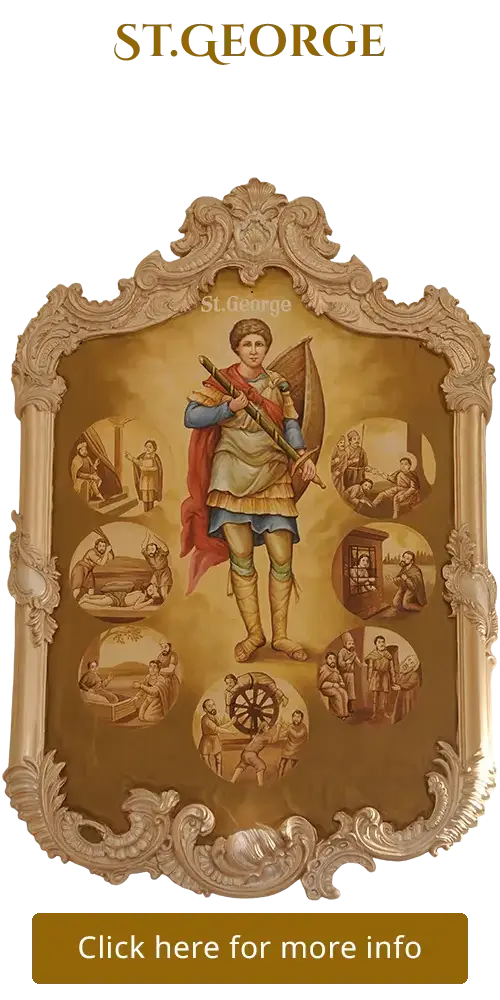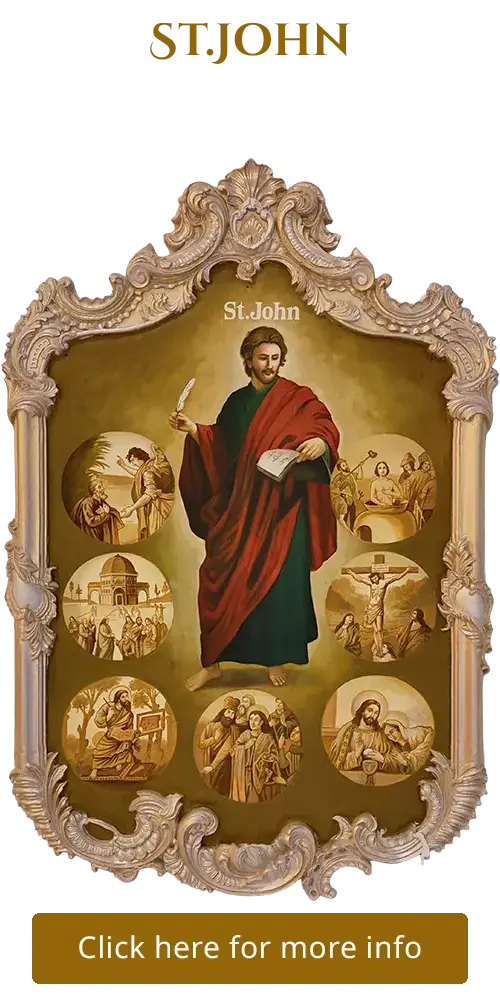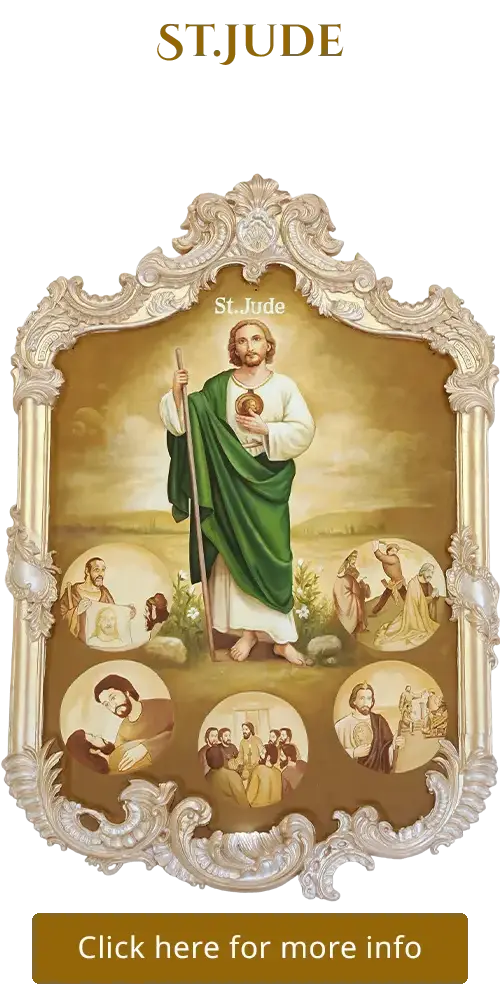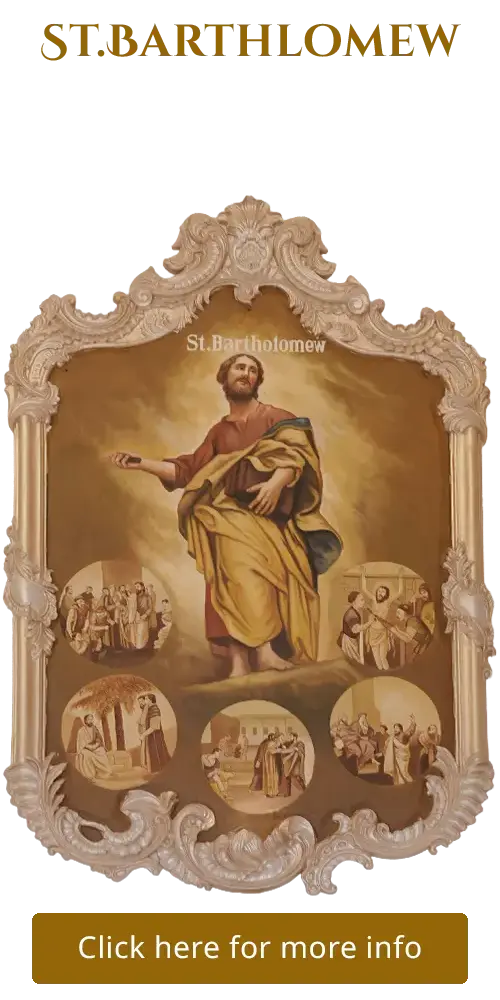St. Jude
Inside Paintings - South Wall
St. Jude
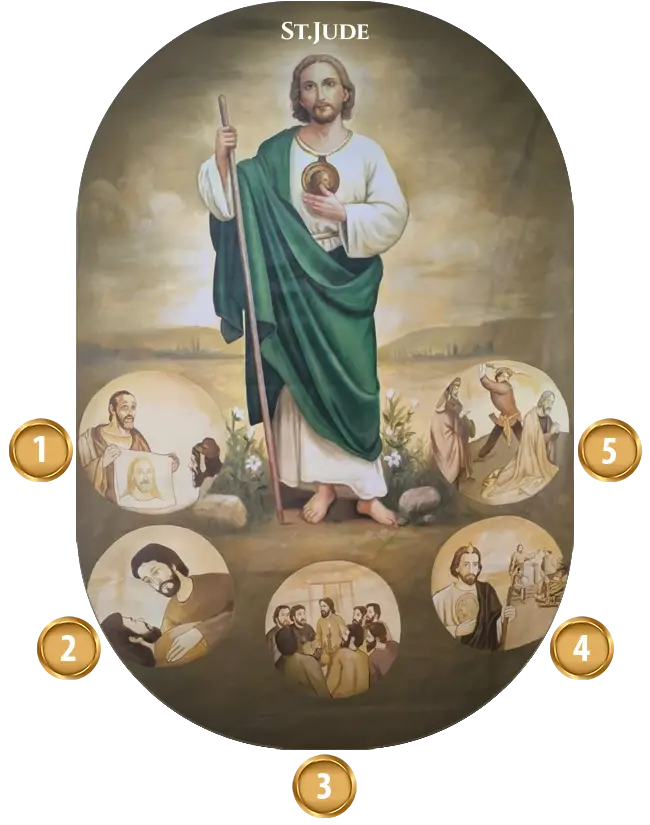


1. Image of Edessa, also known as the Mandylion
Historical reference: Hagiographic tradition – Historia Ecclesiastica, Acts of Thaddeus.
Description: King Abgar V of Edessa (modern-day Urfa, Turkey) was gravely ill, often said to be suffering from leprosy or another serious disease. Hearing of Jesus’ miracles, Abgar sent a letter to Jesus, requesting healing and offering refuge from His persecutors. Jesus responded that He could not come personally but promised to send a disciple after His passion and ascension.
Jesus, moved by Abgar’s faith, pressed His face onto a cloth, miraculously imprinting His image on it. He gave this cloth to Jude Thaddeus, to deliver to Abgar. Upon receiving the cloth, Abgar was miraculously healed and converted to Christianity, along with many in his kingdom.
This cloth, known as the Mandylion in Orthodox tradition, is considered a holy relic and one of the earliest “not-made-by-hands” (acheiropoieta) images of Jesus. It was reportedly venerated in Edessa until it was transferred to Constantinople in 944 CE.
This incident ties to his title as the patron saint of hopeless causes, as the healing of Abgar exemplifies hope in desperate situation.
2. Jude’s Legacy with Jesus
Historical reference: Canonical references, traditional accounts, and apocryphal sources.
Description: Saint Jude Thaddeus, also known as Judas son of James, was one of the Twelve Apostles and had a close relationship with Jesus as a disciple.
Some traditions suggest Jude was a relative of Jesus, possibly a cousin, through his father, James, who may have been a kinsman of Mary. This familial connection, emphasizes Jude’s proximity to Jesus during His ministry.
As an apostle, Jude witnessed Jesus’ miracles and received His commission to preach and heal. St. Jude’s legacy is one of hope, perseverance, and intercessory power, inspiring countless individuals to turn to him in times of need.
St. Jude is also credited with writing the Epistle of Jude, a New Testament letter that encourages believers to remain steadfast in their faith. Epistle warns against false teachers, urges steadfast faith, and emphasizes God’s judgment and mercy. Jude challenges the church to contend for the faith and stay faithful to God. The lives of Jesus’ followers must reflect their faith because God’s grace demands a whole-life response that includes moral living.
3. The Question at the Last Supper
Biblical reference: John 14:21-24
Description: Saint Jude, also known as Jude Thaddeus or Judas son of James, during the Last Supper, asks Jesus a significant question.
During the Last Supper,Jesus speaks about revealing Himself to those who love Him and keep His commandments. In response, Jude asks, “Lord, how is it that you will reveal yourself to us, and not to the world?”. This question reflects Jude’s curiosity or concern about the selective nature of Jesus’ revelation, wondering why Jesus would manifest Himself to the disciples but not broadly to the world.
Jesus’ response explains that those who love Him will keep His word, and He and the Father will dwell with them, implying a spiritual revelation to those who follow Him, rather than a public display. This exchange underscores Jude’s role as a thoughtful disciple, seeking clarity on the nature of Jesus’ mission and the exclusivity of His revelation to the faithful.
Jude’s question is significant because it prompts Jesus to elaborate on the intimate relationship between Himself, the Father, and His followers.
4. Missionary Work & Miracles
Historical reference: Eusebius’ Ecclesiastical History, the Acts of Thaddaeus.
Description: St. Jude Thaddeus, one of the Twelve Apostles, is traditionally associated with missionary work across regions like Judea, Samaria, Syria, Mesopotamia, Persia, and possibly Armenia. Jude preached to Jewish communities, emphasizing Jesus as the Messiah. Jude preached in cities like Babylon and faced hostility from local priests. He is often linked with St. Simon the Zealot in these missions, evangelizing in regions resistant to Christianity. Jude laid the groundwork for Christianity in Armenia, alongside St. Bartholomew. His preaching reportedly converted many.
His preaching and prayers restored sight to the blind in Edessa. Armenian traditions also mention Jude healing the blind during his missions. Jude casted out demons and healed various ailments in Persia. Jude healed a Persian nobleman’s daughter from a debilitating illness, leading the family to embrace Christianity.
Posthumously, devotion to St. Jude grew, with countless miracles attributed to his intercession, particularly for desperate cases. By the Middle Ages, his reputation as the saint of hopeless causes led to widespread reports of healings, including blindness, credited to prayers in his name.
5. Martyrdom
Historical reference: Sacred literature & Tradition
Description: Jude’s martyrdom occurred during his missionary work. Jude faced opposition from local priests and rulers due to his success in converting people to Christianity, often through preaching and miracles like healing the sick and casting out demons. His refusal to worship pagan gods or renounce his faith provoked his execution.
He died in Persia (modern-day Iran) or Berytus (modern-day Beirut, Lebanon), along with Simon the Zealot. Jude is believed to have been clubbed to death and then had his head smashed with an axe by a pagan mob. Jude is frequently mentioned alongside Simon the Zealot, and they are believed to have been martyred together.
After his death, his body was reportedly taken to Rome and placed in St. Peter’s Basilica, where his relics are still venerated.

